25 Aprile 2012
English
Light and Matter
The marbles
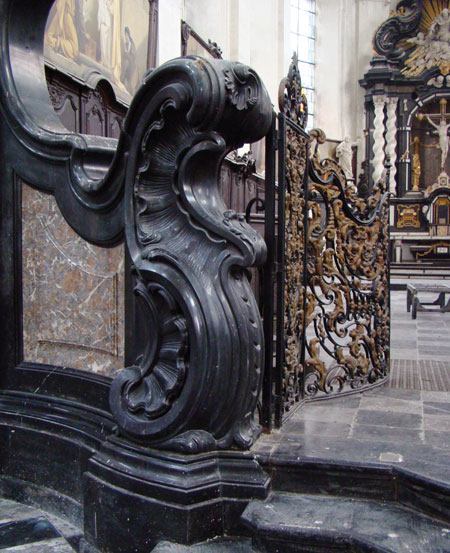
The Noir Belge marble (also known as Belgium Black)
[photogallery]luce_materia_album1[/photogallery]
here are few marbles that radiate as much of an aura of rare elegance, mystery and seduction as the “NOIR BELGE“ or “BELGIAN BLACK“. It has long been thought of as extinct and the last of its quarries closed. It has been copied many times and it’s name has often been abused for trading purposes. Despite this, its unique gloss has still proven beyond imitation and its numerous references all over the world since the Antiquity speak for themseves.
The only existing quarry of this exclusive marble belongs to the Merbes-Sprimont company, originally founded in 1779, today a subsidiary of Solubema company.
Genesis
This marble is a sedimentary rock which can be found in several outcrops of ancient terranes in Southern Belgium.
Virtually vein- and fossil-free, owing to its peculiar sedimentation conditions and to the absence of tectonic deformation, this marble is characterised by unique qualities, which made it be used and appreciated since ancient times. With a pure chemical composition (calcium carbonate: 98.5%), the Belgian Black derives its color from a strong and ancient impregnation of fine-grained organic matter. These two characteristics give the rock the capacity to obtain a mirror-like polish and its unmistakable color. The sedimentary environment in which the originary limestone formed, i.e. still and oxygen-free lagoon waters, are found in several sites dating between upper Devonian (Frasnian) and lower Carboniferous (Visean). To the latter period belong the black Namur and Dinant marbles, as well as those exploited in the Meuse valley and those from Theux and Basecles, in the vicinities of Liège and, finally, the marbles coming from the Hainaut quarries; on the other hand, the marbles quarried at Tournai are of a poorer quality, characterised by a dark grey groundmass and an irregular polish.
The reserves lying in the Orneau valley, northern affluent of the Sambre, are even older, as they date back to Frasnian (375 to 360 My b.p.). The most famous of such superior quality outcrops is the Mazy (Golzinne) black marble, the only one still being exploited today.
Exploitation
The first Belgian Black quarries were initially of the open pit type, but the steeply dipping attitude of the marble layers forced the exploitation to quickly move underground, in a period when Belgium was a leader in coal-mining engineering techniques. This unique knowledge was applied to the exploitation of the black marble by adopting the “chambers and pillars” technique, an excavation method still used to the present day. A 67 m deep shaft was first excavated during the First World War to reach the marble layers; from the first and older chambers, an impressive tunnels network developed, also providing, since a decade, an access for vehicles. The extreme working conditions thus limit the Belgian black marble production. The amount quarried each year is small and is reserved to works of great architectural and artistic importance. The characteristic of fine-grain allows a rich sculptural use of this marble which, enhanced by a proper mastery of techniques, provides a sumptuous range of different appearances, from a satin-smooth honed finish to an incomparable shiny black mirror polished finish.
The Belgium Black is an example of a very fine and rare European industrial and architectural craft, aged well over a millennium.
History
The use of these black marbles goes back to Ancient Times. A number of Latin funerary inscriptions carefully engraved on slabs of this material were discovered near the Roman citadel of Namur. An invaluable piece of evidence of Carolingian times is the famous epitaph of Hadrian I, donated by Emperor Charlemagne himself . This unique example of perfect epigraphy is set above the portal of Saint Peter’s Basilica in Rome, and recent analyses have proved its Belgian origin beyond any doubt. The entire Middle Ages are dominated by intense use of these materials, especially in the area of funerary art but also for baptismal fonts and columns. These items were widely distributed along the key trading routes of the Scheldt and Meuse rivers, allowing them to reach the sea and beyond, and they are to be found all over western Europe, from Scandinavia to Portugal including England.
The Renaissance and Baroque aroused renewed interest in black marbles, from then on used in association with red marbles (also quarried from Frasnian formations in Belgium) or light crystalline marbles and alabasters originating from the whole Mediterranean area. Many and varied applications of black marble, both civil and religious, can be seen to an increasing extent, especially in the churches of the Counter-Reformation, on the altars and on the chancel and chapel barriers, on increasingly magnificent flagstones. Black marbles were used in such places to mark structures and decorations with their powerful lines. At about the same time the “hard stones” craft developed in Italy, especially in Florence and Naples. During the Medici period, the famous Pietre dure, masterpieces of inlaid work, were usually designed on dark backgrounds. The preferred backing stone was referred to as Paragone di Fiandra, which was nothing else but Belgium Black marble. Depending on the political alliances of the Medici, the precious works of art created by skilled Florentine workshops, such as the Opificio delle Pietre Dure, were given as gifts to the major courts of Europe thus contributing to increase the prestige of this unique marble. Due also to an extensive use in Great Britain, our marble even became known as British Black Jasper and is referred to as such by many XVI century scholars. Dating from the same period, the use of black marble for decorative objects, called curios, would develop to include numerous objects such as fireplaces, inkwells, writing cases, book ends, paperweights, etc., frequently associated with gilted bronze, which ornamented every home till the early XXth.
Lastly, as witnessed by many modern creations, artists, architects and designers appreciate this material for its incomparable aesthetic characteristics. Indeed its polymorphic and historical features make it essential as much for Renaissance, Baroque, Classical or Minimalist architecture.
Francis Tourneur
Geologist. General secretary of the association “Stone et Marble de Wallonie”. Lecturer in several universities and schools of architecture, he is also a member of the Royal Commission of Monuments, sites and research for the Walloon region (Belgium). Corresponding member of the International Scientific Committee “stone”of ICOMOS, Francis Tourneur is also author of books and articles on lithic materials and their use.

Merbes Sprimont
Merbes-Sprimont, our Belgium subsidiary, originally established in 1779, quarries the exclusive “Noir Belge“ or unique absolute black marble, the famous “Rouge Griotte“, “Gris des Ardennes“ and “Rouge royal“. Since the Medicis in Florence, the architectural and historical references of these marbles are to be found all over Europe’s most famous royal castles and churches (like Westminster Abbey in UK, Versailles,Vaux le Vicomte or Opera Garnier in France).
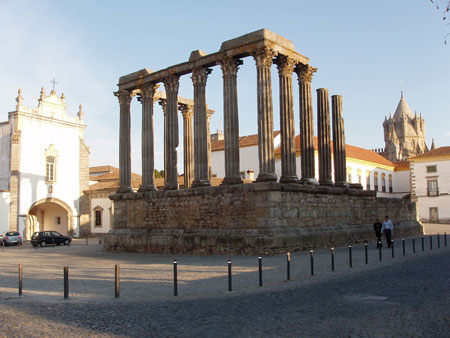
[photogallery]luce_materia_album2[/photogallery]
The Vigaria marbles
Vigaria marbles derive their names from the land property of the “Herdade de Vigaria” , where they are extracted.
In the traditional dichotomy between portuguese white marbles (so called Estremoz type) and the pink ones (Rosa Portugal type), VIGARIA represents a third deposit with its own identity and a rich range of specific colors, types and characteristics such as Vigaria Peach, Vigaria Polar, Vigaria Venatino, etc.. The object of the present project, transparency, is one of its original and exclusive specificities. The “Herdade de Vigaria” is an exclusive property of the Solubema company.
Genesis
These marbles belong to a thick carbonatic sequence, starting with dolomitic limestones at the base and topped by schists of volcanoclastic origin. These ancient metamorphic rocks (dating from late Precambrian to early Cambrian: 650 to 500 M.y. b.p.) crop out in a complex, kilometric-scale anticlinal fold, with a NW-SE trending axis, known as the “Estremoz Anticlinorium”. The accumulation of such a quantity of carbonates and their geometry suggest that the original limestone formed a proto-coral reef, subsequently recrystallised during the Hercynian orogenesis.
The site named “Herdade de Vigaria” is located on the southwestern flank of the Estremoz Anticlinorium. The geological conditions specific to this area induced the formation of a very pure marble, with an extremely fine grain and an uncomparable polish, making it a unique resource in the whole region. The marble colour progressively changes from white, at the base of the sedimentary sequence, to pink towards the top and close to the cover schists. The Vigaria deposit is characterised by a noticeable mineralogical purity (being composed of 98,6% of calcium carbonate) and is considered as the best crystalline marble from Portugal. Its reserves reach the considerable estimation of 650 million tons, i.e. over a thousand years of exploitation at the present rate.
Exploitation
The flat topography caused quarrying to develop mainly in open pits; the first 20 meters from the surface are made of weathered rocks which have to be removed to reach the underlying productive levels. For this reason, the yield of the quarry in terms of workable blocks doesn’t exceed 5% of the total volume.
The study of the layers geometry and a careful adaptation of the extraction methods allows the production of high quality and uniformly colored marble blocks. Finally, a careful stock management ensures the availability and supplies continuity of a proper quality marble, even in the highest standard architectural projects, demanding large quantites of homogeneously colored marble. As environmental impact studies demonstrate, extraction in the Vigaria area by Solubema does not endanger any protected animal or plant species.
History
In ancient times, the crystalline marble quarries from Alentejo have seen their development limited by their distance to the main urban centers. Access being difficult since early XXth century, it’s mainly on a regional scale that architecture used these materials.
Quarries of these areas have nevertheless been known since Antiquity and the earliest evidence of the use of Vigaria marbles dates from the Roman period of Portugal (from II century B.C.). The Roman temple of the nearby city of Evora is a brilliant example, as it displays rich flowery corinthian capitols of this marble topping granite columns.
Bas-relief and column remains have similarly been found on our quarry site itself in the late 1970’s , and were offered to the local museum. As such, Vigaria can be considered as a “cava romana” quarry.
As displayed by the numerous local castles, during the medieval period marble was mostly used for its excellent technical characteristics as a simple building rock. Nor did the Moorish occupation leave significant architectural heritage locally, except for a few inscribed tombstones.
Romanesque and Gothic religious architecture used our marble locally, but the main historical reference shifts to the Baroque period, when King Philip II of Spain built the Escurial Palace near Madrid, which was considered to be the world’s eigth’s wonder in the late XVII. Since then, Baroque architecture used extensively the marbles of Vila Viçosa area for the edification of façades and altars in religious buildings. The Lisbon earthquake of 1755 did unfortunately erase most of the earlier buildings in the city, whose reconstruction mostly used the local Sintra limestone.
The crystalline marble of Vila Viçosa region were quoted in the Universal Exhibition in Paris in 1855 and 1878 and praised for their qualities. But the real development would wait until the early XXth century, when the first railway line would join Vila Viçosa to Lisbon, allowing an easy transport of the marble blocks to the ports. Export quickly began to Spain, Belgium, France, Italy and even USA. In 1928 the Sociedad Luso-Belga de Marmore, also known as Solubema, is founded thanks to the investments and technologies of the famous Belgian company Merbes-Sprimont. The land of the “Herdade de Vigaria” is totally acquired from the beginning of the firm. The history of the Vigaria marble merge therefore with Solubema’s. Its quarrying area being the largest privately owned in Portugal, the Company would employ at its beginning over 1.000 workers in Vigaria and near-by quarries.
On the 24 April 1974, the very same day og the Portuguese revolution , the ETMA Company (Empresa Trasformadora do Marmore do Alentejo) was founded as the subsidiary processing plant of Solubema. In 1977, Solubema’s experienced team would open several marble quarries in Brasil. The end of the XXth century witnessed the reorganization of both Companies and a gradual enlargement of the activity.
Solubema and its subsidiaries employ nowadays in Western Europe over 280 people , who specialize in the extraction, processing and commercialization of marbles and limestones. The Company belongs to the French Marbrek Group, like the CMF Company (Carrières et Marbreries de France). The group of companies is one of today’s significant European producers in this field.
Nuno Costa
o Costa has collaborated with various architectural firms on the Lisbon World Expo in 1998 and worked on the expansion of Madeira and Lisbon airports.
Since 2003, he is responsible for the Architectural division of Etma Company, the marble processing plant subsidiary of Solubema.
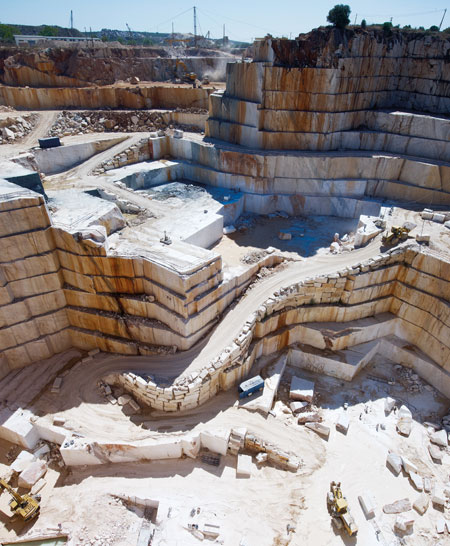
Solubema
Solubema is the largest marble quarrying company of Portugal and one of the European top five. Pioneering the marble mining since 1928, we extract from our own land the exclusive “Marbles of Vigaria“, of unique gloss and alabaster-like trasparency. With a monthly production of 1.500 cubic meters, a ready-to-deliver policy of high quality blocks and a unique range of background colours from icy white to ivory cream, from peach to bright pink, Solubema has the capacity and organization to supply the most demanding architectural projects at very short delay.
Etma
Etma, established in 1974, is the processing plant of Solubema, located on the quarrying site itself.
Provided with an up-to-date powerful and constantly evolving transformation capacity, this factory process all kinds of Portuguese limestones and marbles in standard dimension, cut to size or artistic jobs.
Completed architectural projects
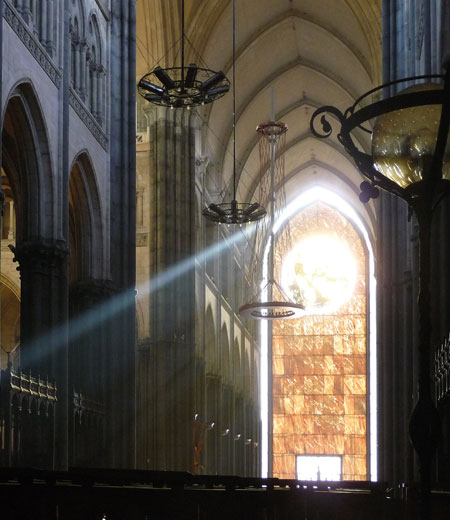
CATHEDRALE NOTRE DAME DE LA TREILLE
The ambitious project of building a Basilica dedicated to the cult of the “Vierge de la Treille”, or “Virgin with the Arbor”, goes back to 1854 in the northern French city of Lille, which hosted her miraculous statue since the Middle Ages. The selected gothic style looked for reference to the French cathedrals of Reims, Amiens and Chartres. The initial project was pharaonic: 132 meters in length and a culminating height of 115 meters for the towers. However, wars and economic problems would stop the construction for most of the following century.
In the years 1990, thanks to a public subscription, works on the main façade were completed. Designed by architect Pierre-Louis Carlier, the building is the result of the conjunction of talents and technical innovations, made possible through participation by the engineer Peter Rice (Sydney Opera House, Pompidou Centre in Paris).
The central part of the church features an arch 30 meters high, hang with 110 slabs of Vigaria marble from Portugal 28 mm thick, supported by a network of steel cables under tension. Inside, this transparent marble veil creates a surprising warm amber light, inlaid with a polychromous circular stained glass on the theme of the Resurrection.
Completed in 1999, the Cathedral of Notre Dame de la Treille is registered as a national monument since 2009.
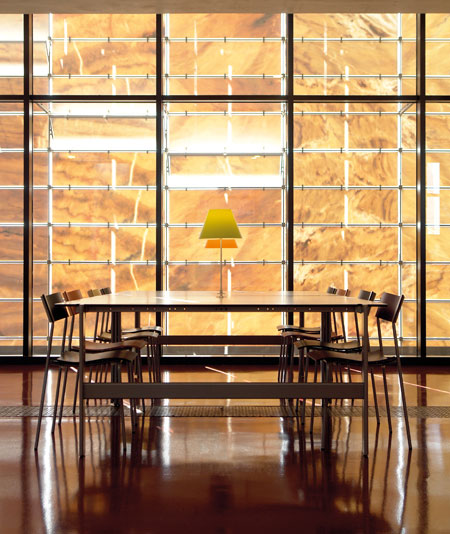
MEDIATHEQUE DU VAL D’EUROPE
The hanging marble façade of the Val d’Europe Library in Serris (Seine et Marne) has been completed in 2006. It has been realized in a contemporary style with a high level of technology and engineering. “It is a mineral screen hanging slightly apart from the main structure wall, producing a soft light and protecting both the books and readers from direct sunshine. The vibration of light between the marble tiles provides a tremulous effect very similar to autumn foliage hit by the sun.” explain the designers, architects Paul Chemetov and Borja Huidobro. The cladding numbers 1.460 marble elements of 1,21m x 0,39m (average) for 25 mm thickness. The overall weight of this screen structure is 42 tons.
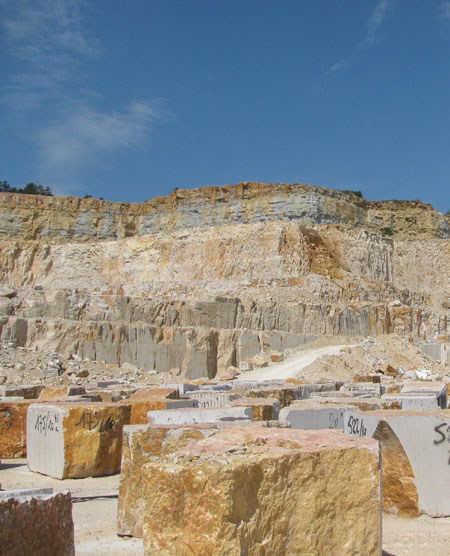
MARBREK
Marbrek, established in 1979, is a French company specialized in artistic and complex cut-to-size projects worldwide, with numerous and prestigious references.
It is also known for its broad range of French limestones and marbles, controlled through its subsidiaries Carrières et Marbreries de France (CMF) and Marpic-France. Marbrek is also the head company of the Solubema/Etma/ Merbes-Sprimont Group.
__________________________________________________________
In partnership with
Serafini Marmo Luce
At “Serafini Marmo Luce” they create delicate marble lamps by using technology, robots and software, in order to let the light shine through the carved stone matter. Each marble lamp is a unique and unrepeatable piece of work, where the substance is submitted to the rigorous shapes of the design and the radiating light adds the value of unequalled charm.
Designer
Raffaello Galiotto studied at the Accademia di Belle Arti in Venice.
At first he worked for companies in the furniture industry, becoming highly experienced in the design of large plastic objects, for high scale production.
He expanded his horizons by applying his knowledge to various other sectors, from outdoor and indoor furniture, to kitchens, to items for pets, to stone products and by so doing encountered and learnt about materials and technologies used for different types of production.
In the stone sector, in particular, and with the close collaboration of firms, Galiotto has created innovative products with new types of surfaces, gaining national and international awards. He collaborates with prestigious Italian universities and holds lectures and conferences with delegations of international architects.
In recent years, he has organised important events about stone design and in collaboration with the CMC (Consorzio Marmisti Chiampo) he has planned and curated two major events: “Palladio e il design litico” and “I Marmi del Doge”, which were exhibited at Marmomacc Verona, and presently in several European cities.
In 2011 Galiotto had a personal show in Beijing, having been invited from Stonetech fair to present his design projects and to hold some lectures on stone design.
LUCE E MATERIA
Credits
promoter
Francis Kezirian
editor and designer
Raffaello Galiotto
3D, rendering, graphic
Studio Raffaello Galiotto
Eleonora Vaccaretti
Federica Negro
Giorgio Parise
marble and craft
SOLUBEMA Portugal
ETMA Portugal
DE MERBES SPRIMONT Belgium
MARBREK France
press
Busa e Associati relazioni pubbliche
partner
Serafini Marmo Luce
set up
Tecnostruttura di Andrea Battivello
thanks to
Marmomacc 2011, Verona
